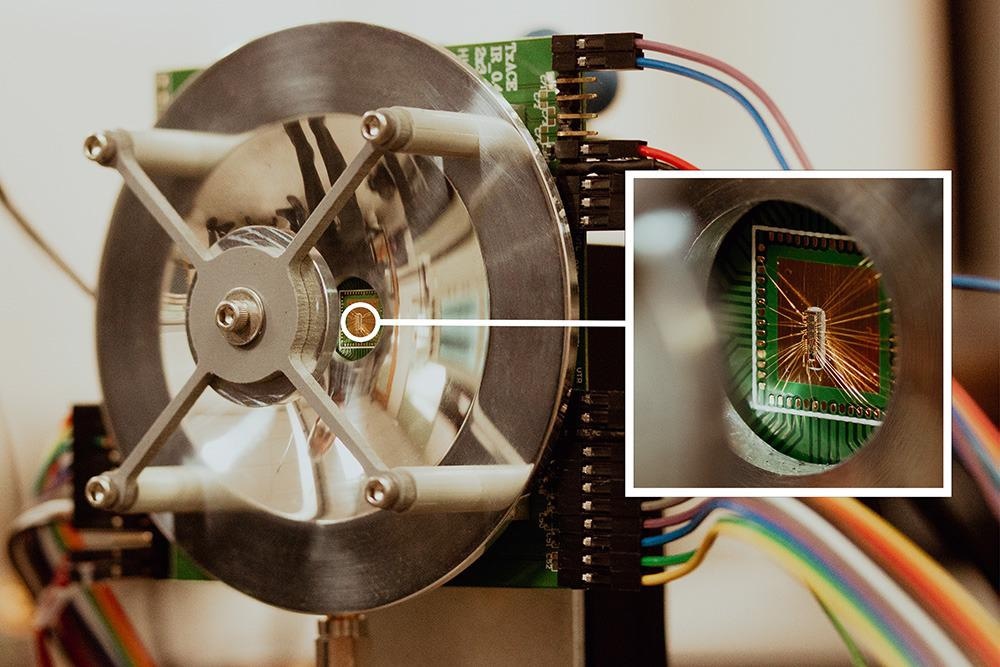Scientists from the University of Texas at Dallas (UTD) and Oklahoma State University have engineered an innovative terahertz imager microchip that allows devices to sense objects and form images through obstacles that include smoke, dust, fog and snow.
 The terahertz imager features a microchip (see inset) and a reflector that increases the imaging distance and quality and reduces power consumption. The microchip emits radiation beams in the terahertz range (430 GHz) of the electromagnetic spectrum from pixels no larger than a grain of sand. The beams travel through obstacles that optical light cannot penetrate and bounce off objects and back to the microchip, where the pixels pick up the signal to create images. Image Credit: The University of Texas at Dallas.
The terahertz imager features a microchip (see inset) and a reflector that increases the imaging distance and quality and reduces power consumption. The microchip emits radiation beams in the terahertz range (430 GHz) of the electromagnetic spectrum from pixels no larger than a grain of sand. The beams travel through obstacles that optical light cannot penetrate and bounce off objects and back to the microchip, where the pixels pick up the signal to create images. Image Credit: The University of Texas at Dallas.
The scientists are tweaking a device for industrial applications that necessitate imaging up to 20 m away. The technology could also be modified and used in cars to help drivers or autonomous vehicle systems steer through unsafe conditions that decrease visibility. On an automotive display, for example, the technology could display pixelated outlines and shapes of objects, such as pedestrians or another vehicle.
The technology allows you to see in vision-impaired environments. In industrial settings, for example, devices using the microchips could help with packaging inspections for manufacturing process control, monitoring moisture content, or seeing through steam. If you are a firefighter, it could help you see through smoke and fire.
Dr. Kenneth K. O, Professor of Electrical and Computer Engineering and Texas Instruments Distinguished University Chair, Erik Jonsson School of Engineering and Computer Science, UTD
Yukun Zhu, a doctoral candidate in electrical engineering, presented the imaging technology on February 21st at the virtual International Solid-State Circuits Conference, supported by the Institute of Electrical and Electronics Engineers (IEEE) and its Solid-State Circuits Society.
The innovation is the result of over 15 years of work by O and his group of students, scientists and collaborators. This most recent effort is backed by Texas Instruments (TI) through its TI Foundational Technology Research Program.
“TI has been part of the journey through much of the 15 years,” said O, who is director of the Texas Analog Center of Excellence (TxACE) at UT Dallas. “The company has been a key supporter of the research.”
The microchip discharges radiation beams in the terahertz range (430 GHz) of the electromagnetic spectrum from pixels no bigger than a grain of sand. The beams move through dust, fog and other hindrances that optical light cannot enter and rebound off objects and return to the microchip, where the pixels capture the signal to form images.
Without the employing of external lenses, the terahertz imager incorporates the microchip and a reflector that extends the imaging distance and quality and decreases the consumption of power.
The scientists built the imager using complementary metal-oxide semiconductor (CMOS) technology. This variety of integrated circuit technology is used to mass-produce consumer electronics devices, which makes the imager economical. O’s group was one of the first to demonstrate that CMOS technology was feasible, and since then they have strived to create a range of new applications.
The key thing about the terahertz imager is making the pixels small and low power. You need to integrate a transmitter, receiver, and antenna in such a small area.
Dr. Wooyeol Choi, Assistant Professor of Electrical and Computer Engineering, Oklahoma State University, UTD
Dr. Choi is also a former assistant research professor at UTD, where he began the work on the technology with O, while O is a fellow of the IEEE.
Another breakthrough result enabled through innovations that overcame fundamental active-gain limits of CMOS is that this imaging technology consumes more than 100 times less power than the phased arrays currently being investigated for the same imaging applications. This and the use of CMOS make consumer applications of this technology possible.
Dr. Kenneth K. O, Professor of Electrical and Computer Engineering and Texas Instruments Distinguished University Chair, Erik Jonsson School of Engineering and Computer Science, UTD
TxACE is backed by the Semiconductor Research Corp., TI, the UT System, and UTD.
“UT Dallas and Oklahoma State continue to discover technological innovations that will help shape the future,” said Dr. Swaminathan Sankaran, design director and Distinguished Technical Staff Member at TI Kilby Labs.
What Dr. O and his research team were able to accomplish was truly remarkable with this terahertz monostatic reflection-mode imager work. Their research paves a path for improved raw angular resolution and low-power, cost system integration, and we are excited to see what applications and use cases this terahertz imaging technology will lead to.
Dr. Swaminathan Sankaran, Design Director and Distinguished Member Technical Staff, TI Kilby Labs